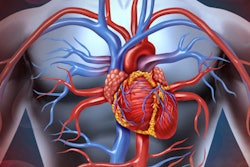
A shortage in the U.S. supply of contrast media used heavily in interventional radiology is driving changes in hospital practices. Clinicians in North Carolina say they adapted quickly, and they offered their strategy in a May 19 report in the Journal of Vascular and Interventional Radiology.
A group of physicians led by Dr. Nicole Keefe at the University of North Carolina (UNC) Medical Center in Chapel Hill proposed an initial approach to case prioritization, as well as short-term strategies for management of existing supply to optimize utility and minimize waste.
"From a diagnostic standpoint, all available imaging that could be changed to a different modality was changed," Keefe told AuntMinnie.com.
In May, GE Healthcare announced a supply chain disruption affecting the global supply of iohexol and iodixanol (Omnipaque and Visipaque) caused by COVID-19 pandemic-related factory closures in Shanghai, China, where much of the world's supply of the agents is manufactured.
The plant has since resumed operations, yet supplies remain partial and back ordered, with full stock not anticipated until July, GE said.
"The contrast shortage has significantly affected our hospital at UNC," Keefe said.
Currently, a clinical leadership team at UNC's level 1 trauma center is coordinating targeted use of contrast on the basis of patient acuity in all procedural areas in the hospital, including neurointerventional radiology, interventional cardiology, vascular surgery, urology, radiation oncology, orthopedic surgery, and advanced gastroenterology.
Clinicians in each of these areas have been asked to triage examinations into three categories:
- Emergent, must be done as soon as possible (i.e., embolization or stent graft placement for active bleeding, or thrombolysis or thrombectomy for acute venous thromboembolic events with complicating features)
- Can be delayed by up to one month (i.e, embolization of endoleak in endografted abdominal aortic aneurysm, or venography for dialysis access planning)
- Can be delayed by three months (i.e., embolization for benign prostatic hypertrophy, or recanalization, stent placement, or embolization of deep venous disease)
Procedures are currently being predominantly performed with intravascular ultrasound, intracardiac echocardiography, and alternative contrast agents, such as carbon dioxide, gadolinium, ethiodized oil, barium, or room air, as appropriate, Keefe explained.
For emergent procedures for which iodinated contrast material is absolutely required, efforts to optimize imaging software during emergency procedures are being emphasized to maximize the efficiency and yield of contrast media used per case, she added.
To reduce waste and conserve supply, UNC is using a central pharmacy to distribute contrast media, including repackaging in smaller aliquots. At the point of care, implementation of multiuse valved equipment can extend the use of multiuse contrast media vials and minimize waste, the group wrote in the Journal of Vascular and Interventional Radiology article.
In addition, according to individual imaging conditions, the dilution of contrast media with saline may still provide sufficient imaging quality, according to the authors.
"While iodinated CM have been the standard for interventional procedures for over 60 years, the current global shortage requires the proceduralist to reevaluate this commodity. The prioritization of emergent and urgent procedures with postponement of others may help to ride out the shortage," Keefe and colleagues wrote.
Dr. Gloria Salazar, UNC's chief of vascular and interventional radiology, said that harmonized leadership was key as the team engaged in a rapid change of workflow for both diagnostic and interventional teams, including nonradiological divisions that also use iodinated contrast.
She noted that initial steps at UNC were described in a special commentary focused on CT imaging published May 17 in the Journal of the American College of Radiology.
"We have also learned that contrast utilization could be better optimized, and we will likely continue to utilize mitigation strategies, even after we normalize our supply levels," she told AuntMinnie.com.
Ultimately, Keefe added that many departments have already been facing shortages of numerous devices throughout the COVID-19 pandemic and have learned to adapt to alternative materials.
"As interventionalists, adaptation is at the core of our specialty," she concluded.



















